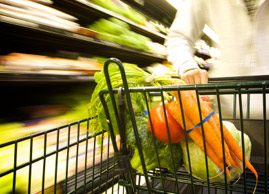5 tricks to waste less food
Follow these five steps to throw out less food and save money on your grocery bill

If your fridge is typical, there’s probably a collection of over-ripe produce, a few stale-dated jars of condiments and a chunk or two of cheese slowly going bad in the back. In the US and the UK (there are no local statistics, but the trend surely holds for Canada), the average family throws away about one-third of the food they purchase.
In the UK this equates to roughly 1.3 million unopened yogurts, 660,000 eggs, 5.1 million potatoes and 2.8 million tomatoes being thrown away’every day. In Canada, where an average family spends about $7,300 on food a year, this means each household is throwing away $2,400 annually. And this doesn’t even begin to take into account the cost of disposing of all that food or the effect the whole process has on the environment.
So what do we do? Chef Alvin Rebick, kitchen manager of FoodShare Toronto, says the first step to stemming waste is to start enjoying all the steps in making food. ‘We think of shopping and cooking as a mind-numbing experience, when it should be pleasurable,’ he says. Make food prep easier’and lessen waste’with these five habits to pick up.
1. Check the fridge
Rebick suggests going through your fridge and pantry properly before shopping. ‘Everyone’s had that experience of buying something you already had.’ If you organize your fridge with the oldest food at the front you’ll use it up first. And don’t toss anything just because it’s nearing its best before date’things don’t necessarily go bad the next day.
2. Plan ahead
Meal plans may seem like work, but Jennifer Nesset, a dietitian in Prince George, B.C., points out that knowing what you’re going to cook can keep you on track in the grocery store: ‘Buying what you need rather than what catches your eye means you’re not just going to throw stuff in your cart and hope to make a meal of it.’ Nesset says your meal plan doesn’t need to be elaborate’it just has to be detailed enough to steer you past the convenience foods and keep you focused on buying only what you need.
3. Skip the giant packages
Rebick says that buying what you need when you need it is more economical and often more enjoyable than filling your cart in one marathon shopping trip. ‘Ideally we would shop every day," he says. "It’s quicker, more relaxing and you’ll waste less.’ If you are shopping weekly, he suggests avoiding bulk purchases. ‘Buying in bulk rarely saves you money because you end up wasting more. When you purchase giant packages or two-for-ones you’re getting convenience, not value.’
4. Make "fridge soup"
There’s a reason that our parents and grandparents made so many soups, stews, curries and casseroles’they’re the perfect way to use up the not-so-beautiful ingredients. And you don’t need to stick to a recipe, says Rebick’just use what you have and experiment. ‘It’s hard to go wrong with a bowl of soup.’ You can also use up extra onions, celery or carrots to make soup stock for freezing.
5. Use your leftovers
Meal planning can help you make just enough for dinner, but Nesset says that sometimes, making a bit extra can be a time saver. ‘Leftovers are perfect for lunches," she says. "Try making chicken salad or having a cold burger sandwich.’ Another option is to make enough extra to freeze in meal-size portions‘just make sure you label and date the food so you don’t forget to use it.
Rebick says one of the best benefits of wasting less is it frees up your food budget so you can spend on things you might not normally buy. ‘You can splurge on small amounts of really special ingredients when you’re not buying large quantities that you just toss away.’
Don’t miss out! Sign up for our free weekly newsletters and get nutritious recipes, healthy weight-loss tips, easy ways to stay in shape and all the health news you need, delivered straight to your inbox.




